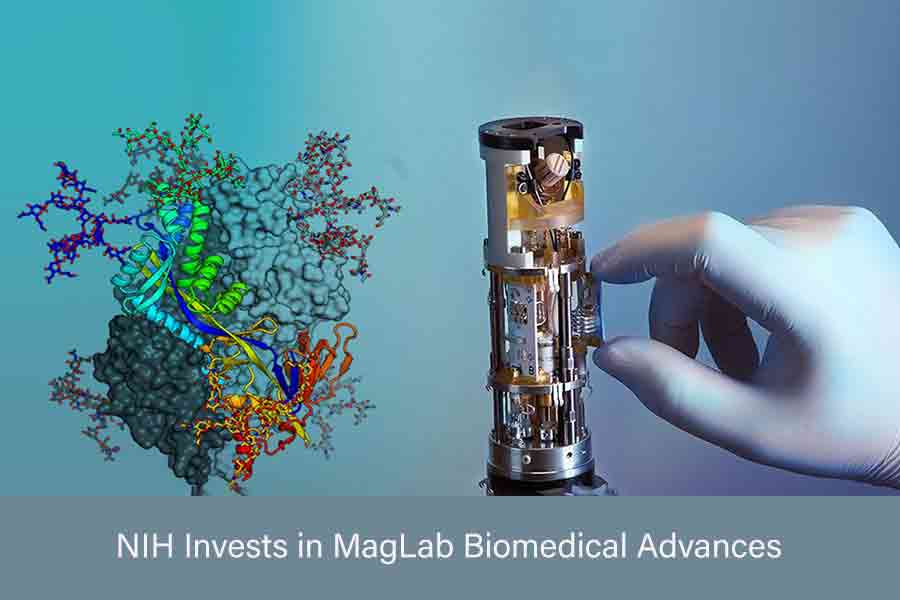
Researchers at the Florida State University-headquartered National High Magnetic Field Laboratory will receive $5.3 million from the National Institutes of Health over the next five years to develop new techniques to probe the intricate processes of the human body.
The funding will spur technological advances at the the MagLab’s powerful Nuclear Magnetic Resonance facilities at both its Florida State University and University of Florida locations and enable research into key biochemical and biological processes at the molecular level. Clearer pictures of biomolecules can advance our understanding of health, various diseases, and related complications and cures, including fatty liver disease, fungal infections, and drug resistant bacteria.
“We’re thrilled to have this funding,” said Rob Schurko, NMR/MRI Program Director at the MagLab, FSU Professor of Chemistry. “NMR offers the potential to observe the most subtle changes and differences in molecular structure – but the NMR signals are terribly weak. So, a major focus of this grant will be about developing the technology required to boost NMR signals and applying it to really complicated problems and systems in biochemistry and biomedicine.”
The NIH funding will advance three areas of technology development at the MagLab.
The first focus is use of superconducting detectors to give NMR enough sensitivity to analyze extracts from biological fluids such as blood and urine. This is NMR researcher Bill Brey’s area of expertise. Brey is a co-principal investigator on the grant and Research Faculty at MagLab/FSU.
“This NIH grant gives our technology group the additional resources we need to use new technology to help solve problems in basic biological sciences that are key to improving health care,” Brey said.
The second focus will be enhancing a process called Dynamic Nuclear Polarization, which uses special chemical additives known as biradicals, along with microwave radiation, to enhance the NMR signal from molecules that are hard to observe using conventional instruments.
And the final focus leverages the record-high magnetic fields found only at the MagLab, including the world’s strongest NMR magnet, the 36 Tesla Series Connected Hybrid, along with a 32 Tesla All-Superconducting Magnet, and a world-class 14.1 Tesla dynamic nuclear polarization NMR platform.
“We have the highest fields at MagLab,” Schurko said. “So let’s try to use them and get some wild science done,” Schurko said, “This NIH project represents a really integrated approach involving a lot of talented people at MagLab, FSU, UF, and from around the world.”
One of the ultimate goals in pushing the NMR technology to new limits is opening up the Periodic Table of Elements to investigate biological systems, since many elements of importance in biology have isotopes that are very hard to see with NMR techniques.
This new NIH funding renews a grant first awarded to the MagLab in 2017 to create a Biomedical Technology Resource Center.
“Over the last 5 years, with funding from our previous grant, we have been able to investigate oxygen and calcium sites in biomolecules and biomaterials. This work has paved the way for future NMR experiments on zinc, copper, sulfur, and maybe even iron. These are some of the most challenging elements for NMR,” Schurko said.
The co-principal investigators, Schurko, Brey, and Joanna Long from UF, will be joined by seven other faculty and staff scientists in conducting research. The Biotechnology Center will also feature 30 collaborators from eight countries, as well as personnel from the UF College of Medicine and UF Department of Chemistry.
Funded by the National Institute for General Medical Sciences (NIGMS), the MagLab team will also train a new generation of NMR users, including graduate and undergraduate students, through workshops, educational activities, and many publications and presentations.
“The MagLab is a world-unique resource for U.S. and international scientists alike. This grant will go far to creating new research opportunities and technologies that would otherwise not be possible,” said Schurko.




